Business Law Assignment: Negligence and Misrepresentation Analysis
VerifiedAdded on 2020/03/28
|8
|2706
|71
Report
AI Summary
This report delves into the concepts of negligence and misrepresentation within the context of business law. It defines negligence as a failure to exercise reasonable care, leading to harm, and misrepresentation as providing false information to induce a contract. The report outlines the legal framework, including the elements needed to prove negligence, such as duty of care, breach of duty, and causation. It explores defenses against negligence claims, including contributory and comparative negligence, and assumption of risk. The report also presents real-life case studies illustrating negligence and misrepresentation in business settings, such as workplace injuries and fraudulent contracts. It further examines the liability of statutory authorities and other relevant torts. The report concludes by emphasizing the importance of maintaining a duty of care to avoid legal repercussions and protect stakeholders.
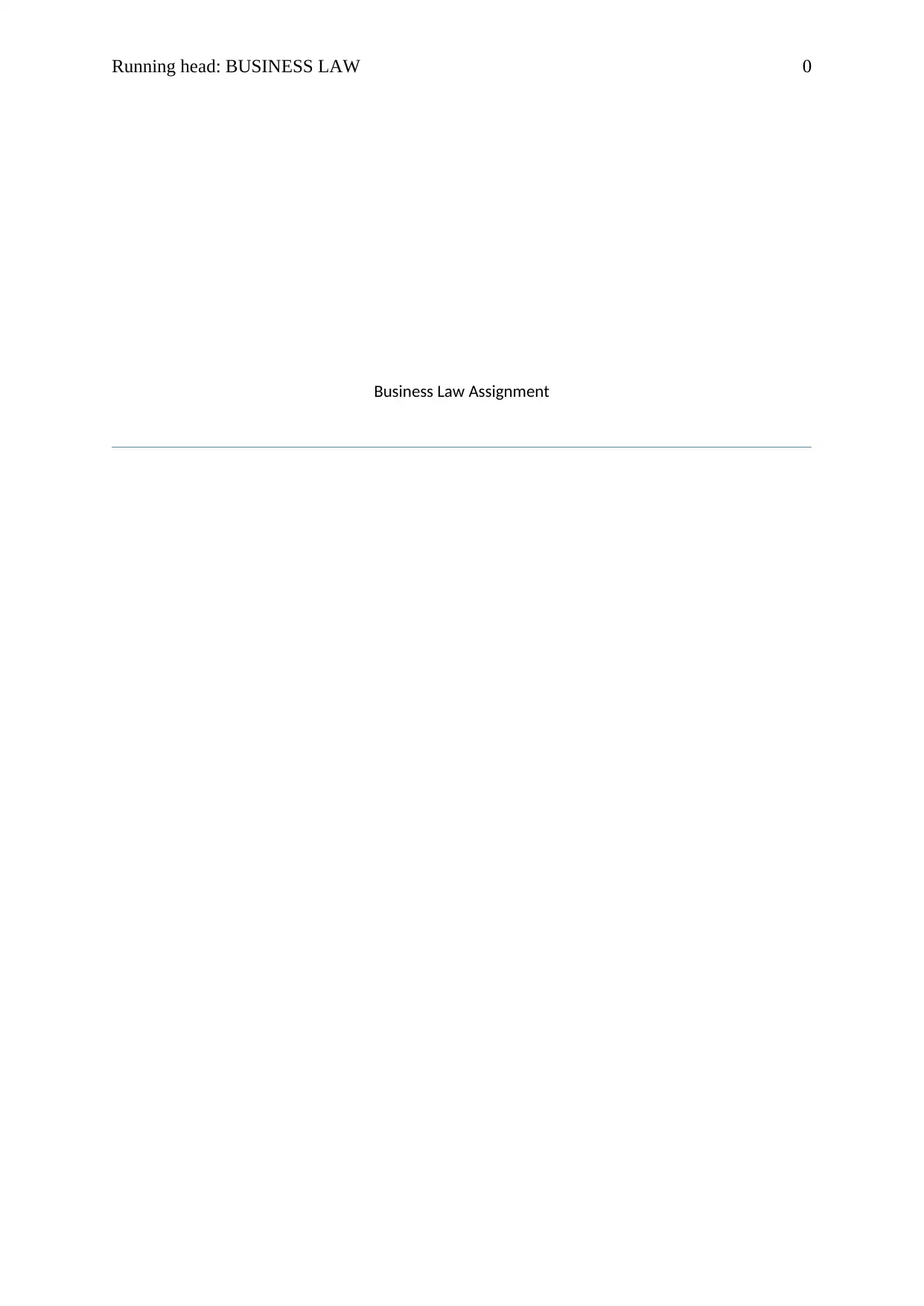
Running head: BUSINESS LAW 0
Business Law Assignment
Business Law Assignment
Paraphrase This Document
Need a fresh take? Get an instant paraphrase of this document with our AI Paraphraser
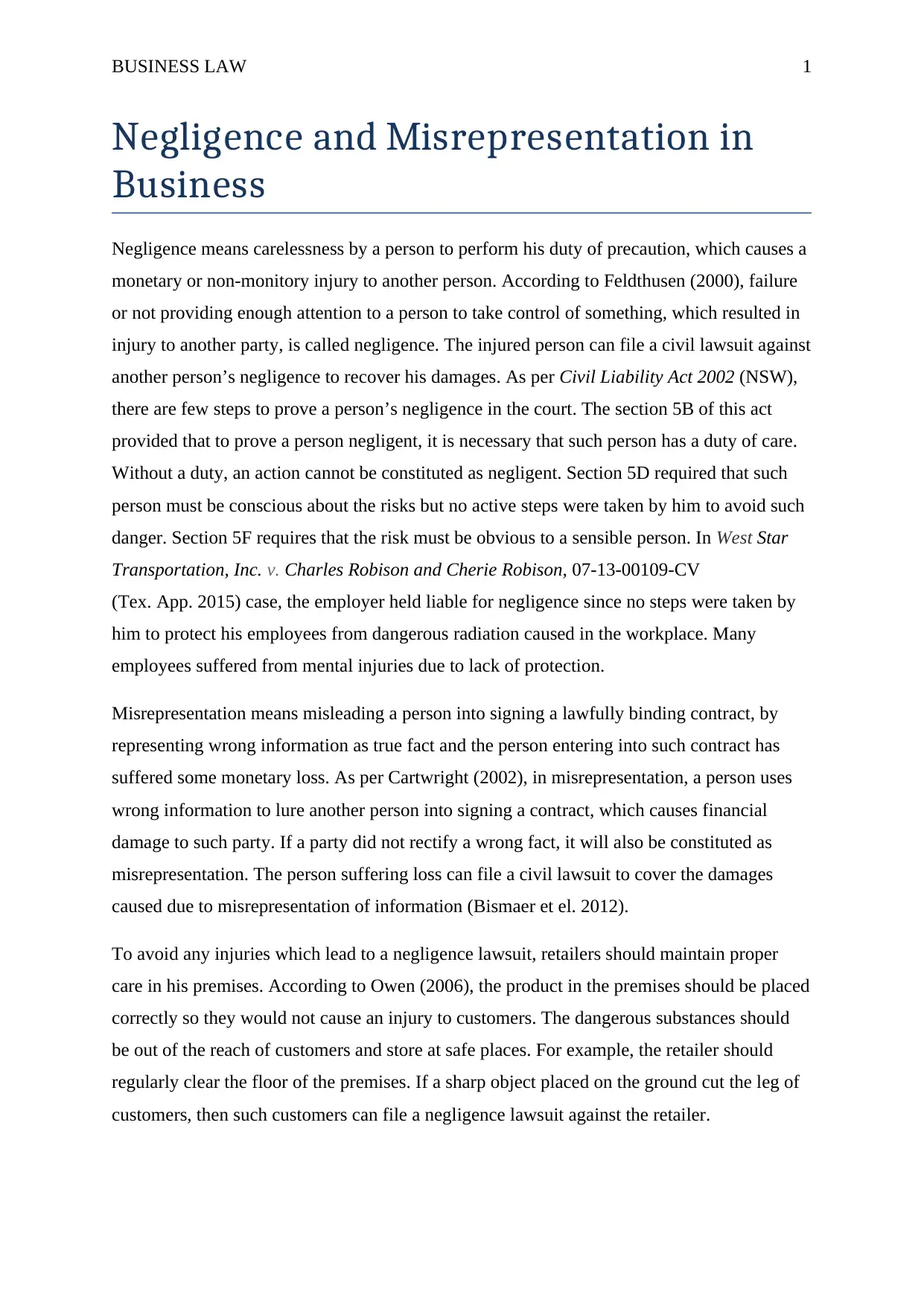
BUSINESS LAW 1
Negligence and Misrepresentation in
Business
Negligence means carelessness by a person to perform his duty of precaution, which causes a
monetary or non-monitory injury to another person. According to Feldthusen (2000), failure
or not providing enough attention to a person to take control of something, which resulted in
injury to another party, is called negligence. The injured person can file a civil lawsuit against
another person’s negligence to recover his damages. As per Civil Liability Act 2002 (NSW),
there are few steps to prove a person’s negligence in the court. The section 5B of this act
provided that to prove a person negligent, it is necessary that such person has a duty of care.
Without a duty, an action cannot be constituted as negligent. Section 5D required that such
person must be conscious about the risks but no active steps were taken by him to avoid such
danger. Section 5F requires that the risk must be obvious to a sensible person. In West Star
Transportation, Inc. v. Charles Robison and Cherie Robison, 07-13-00109-CV
(Tex. App. 2015) case, the employer held liable for negligence since no steps were taken by
him to protect his employees from dangerous radiation caused in the workplace. Many
employees suffered from mental injuries due to lack of protection.
Misrepresentation means misleading a person into signing a lawfully binding contract, by
representing wrong information as true fact and the person entering into such contract has
suffered some monetary loss. As per Cartwright (2002), in misrepresentation, a person uses
wrong information to lure another person into signing a contract, which causes financial
damage to such party. If a party did not rectify a wrong fact, it will also be constituted as
misrepresentation. The person suffering loss can file a civil lawsuit to cover the damages
caused due to misrepresentation of information (Bismaer et el. 2012).
To avoid any injuries which lead to a negligence lawsuit, retailers should maintain proper
care in his premises. According to Owen (2006), the product in the premises should be placed
correctly so they would not cause an injury to customers. The dangerous substances should
be out of the reach of customers and store at safe places. For example, the retailer should
regularly clear the floor of the premises. If a sharp object placed on the ground cut the leg of
customers, then such customers can file a negligence lawsuit against the retailer.
Negligence and Misrepresentation in
Business
Negligence means carelessness by a person to perform his duty of precaution, which causes a
monetary or non-monitory injury to another person. According to Feldthusen (2000), failure
or not providing enough attention to a person to take control of something, which resulted in
injury to another party, is called negligence. The injured person can file a civil lawsuit against
another person’s negligence to recover his damages. As per Civil Liability Act 2002 (NSW),
there are few steps to prove a person’s negligence in the court. The section 5B of this act
provided that to prove a person negligent, it is necessary that such person has a duty of care.
Without a duty, an action cannot be constituted as negligent. Section 5D required that such
person must be conscious about the risks but no active steps were taken by him to avoid such
danger. Section 5F requires that the risk must be obvious to a sensible person. In West Star
Transportation, Inc. v. Charles Robison and Cherie Robison, 07-13-00109-CV
(Tex. App. 2015) case, the employer held liable for negligence since no steps were taken by
him to protect his employees from dangerous radiation caused in the workplace. Many
employees suffered from mental injuries due to lack of protection.
Misrepresentation means misleading a person into signing a lawfully binding contract, by
representing wrong information as true fact and the person entering into such contract has
suffered some monetary loss. As per Cartwright (2002), in misrepresentation, a person uses
wrong information to lure another person into signing a contract, which causes financial
damage to such party. If a party did not rectify a wrong fact, it will also be constituted as
misrepresentation. The person suffering loss can file a civil lawsuit to cover the damages
caused due to misrepresentation of information (Bismaer et el. 2012).
To avoid any injuries which lead to a negligence lawsuit, retailers should maintain proper
care in his premises. According to Owen (2006), the product in the premises should be placed
correctly so they would not cause an injury to customers. The dangerous substances should
be out of the reach of customers and store at safe places. For example, the retailer should
regularly clear the floor of the premises. If a sharp object placed on the ground cut the leg of
customers, then such customers can file a negligence lawsuit against the retailer.
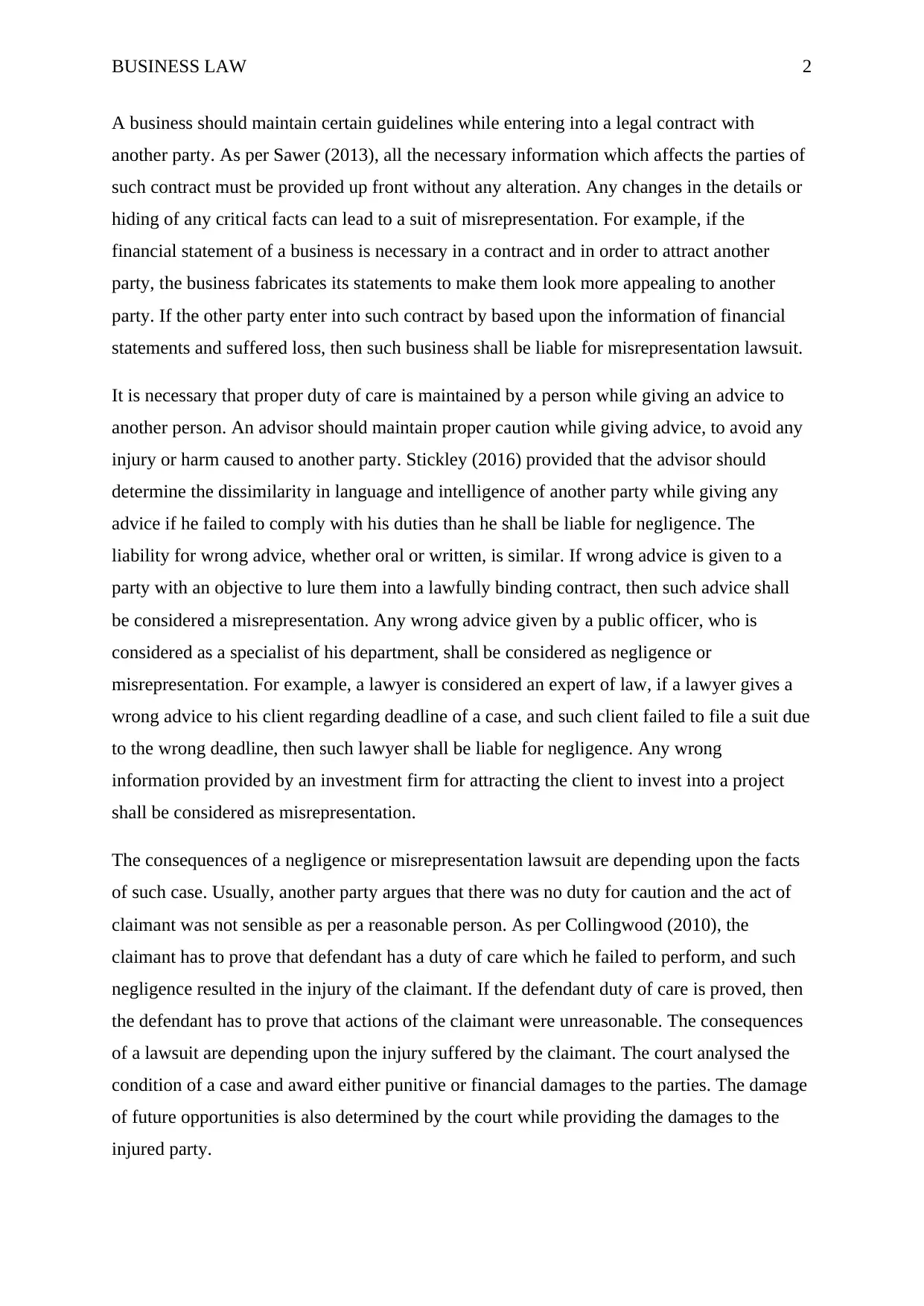
BUSINESS LAW 2
A business should maintain certain guidelines while entering into a legal contract with
another party. As per Sawer (2013), all the necessary information which affects the parties of
such contract must be provided up front without any alteration. Any changes in the details or
hiding of any critical facts can lead to a suit of misrepresentation. For example, if the
financial statement of a business is necessary in a contract and in order to attract another
party, the business fabricates its statements to make them look more appealing to another
party. If the other party enter into such contract by based upon the information of financial
statements and suffered loss, then such business shall be liable for misrepresentation lawsuit.
It is necessary that proper duty of care is maintained by a person while giving an advice to
another person. An advisor should maintain proper caution while giving advice, to avoid any
injury or harm caused to another party. Stickley (2016) provided that the advisor should
determine the dissimilarity in language and intelligence of another party while giving any
advice if he failed to comply with his duties than he shall be liable for negligence. The
liability for wrong advice, whether oral or written, is similar. If wrong advice is given to a
party with an objective to lure them into a lawfully binding contract, then such advice shall
be considered a misrepresentation. Any wrong advice given by a public officer, who is
considered as a specialist of his department, shall be considered as negligence or
misrepresentation. For example, a lawyer is considered an expert of law, if a lawyer gives a
wrong advice to his client regarding deadline of a case, and such client failed to file a suit due
to the wrong deadline, then such lawyer shall be liable for negligence. Any wrong
information provided by an investment firm for attracting the client to invest into a project
shall be considered as misrepresentation.
The consequences of a negligence or misrepresentation lawsuit are depending upon the facts
of such case. Usually, another party argues that there was no duty for caution and the act of
claimant was not sensible as per a reasonable person. As per Collingwood (2010), the
claimant has to prove that defendant has a duty of care which he failed to perform, and such
negligence resulted in the injury of the claimant. If the defendant duty of care is proved, then
the defendant has to prove that actions of the claimant were unreasonable. The consequences
of a lawsuit are depending upon the injury suffered by the claimant. The court analysed the
condition of a case and award either punitive or financial damages to the parties. The damage
of future opportunities is also determined by the court while providing the damages to the
injured party.
A business should maintain certain guidelines while entering into a legal contract with
another party. As per Sawer (2013), all the necessary information which affects the parties of
such contract must be provided up front without any alteration. Any changes in the details or
hiding of any critical facts can lead to a suit of misrepresentation. For example, if the
financial statement of a business is necessary in a contract and in order to attract another
party, the business fabricates its statements to make them look more appealing to another
party. If the other party enter into such contract by based upon the information of financial
statements and suffered loss, then such business shall be liable for misrepresentation lawsuit.
It is necessary that proper duty of care is maintained by a person while giving an advice to
another person. An advisor should maintain proper caution while giving advice, to avoid any
injury or harm caused to another party. Stickley (2016) provided that the advisor should
determine the dissimilarity in language and intelligence of another party while giving any
advice if he failed to comply with his duties than he shall be liable for negligence. The
liability for wrong advice, whether oral or written, is similar. If wrong advice is given to a
party with an objective to lure them into a lawfully binding contract, then such advice shall
be considered a misrepresentation. Any wrong advice given by a public officer, who is
considered as a specialist of his department, shall be considered as negligence or
misrepresentation. For example, a lawyer is considered an expert of law, if a lawyer gives a
wrong advice to his client regarding deadline of a case, and such client failed to file a suit due
to the wrong deadline, then such lawyer shall be liable for negligence. Any wrong
information provided by an investment firm for attracting the client to invest into a project
shall be considered as misrepresentation.
The consequences of a negligence or misrepresentation lawsuit are depending upon the facts
of such case. Usually, another party argues that there was no duty for caution and the act of
claimant was not sensible as per a reasonable person. As per Collingwood (2010), the
claimant has to prove that defendant has a duty of care which he failed to perform, and such
negligence resulted in the injury of the claimant. If the defendant duty of care is proved, then
the defendant has to prove that actions of the claimant were unreasonable. The consequences
of a lawsuit are depending upon the injury suffered by the claimant. The court analysed the
condition of a case and award either punitive or financial damages to the parties. The damage
of future opportunities is also determined by the court while providing the damages to the
injured party.
⊘ This is a preview!⊘
Do you want full access?
Subscribe today to unlock all pages.

Trusted by 1+ million students worldwide
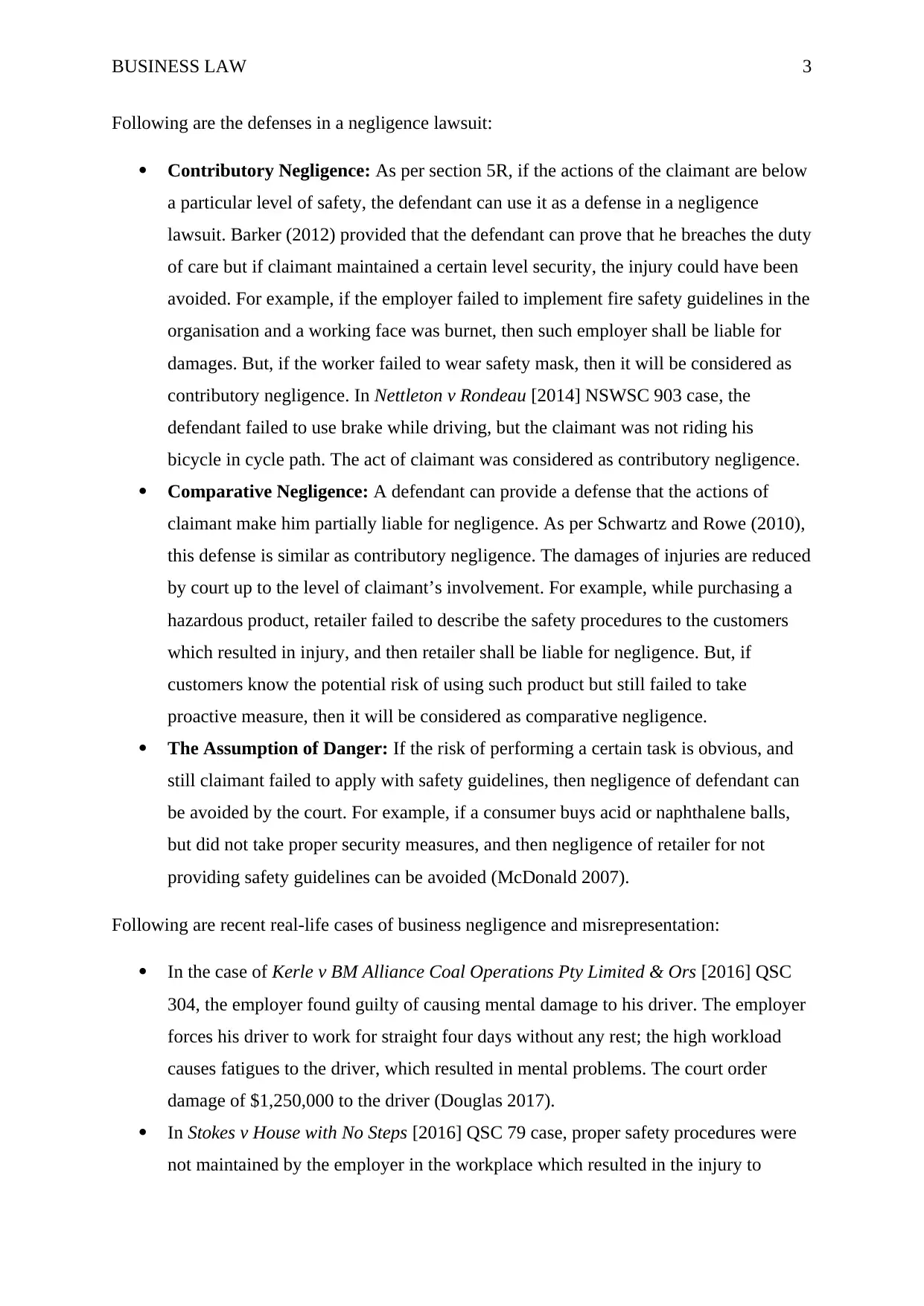
BUSINESS LAW 3
Following are the defenses in a negligence lawsuit:
Contributory Negligence: As per section 5R, if the actions of the claimant are below
a particular level of safety, the defendant can use it as a defense in a negligence
lawsuit. Barker (2012) provided that the defendant can prove that he breaches the duty
of care but if claimant maintained a certain level security, the injury could have been
avoided. For example, if the employer failed to implement fire safety guidelines in the
organisation and a working face was burnet, then such employer shall be liable for
damages. But, if the worker failed to wear safety mask, then it will be considered as
contributory negligence. In Nettleton v Rondeau [2014] NSWSC 903 case, the
defendant failed to use brake while driving, but the claimant was not riding his
bicycle in cycle path. The act of claimant was considered as contributory negligence.
Comparative Negligence: A defendant can provide a defense that the actions of
claimant make him partially liable for negligence. As per Schwartz and Rowe (2010),
this defense is similar as contributory negligence. The damages of injuries are reduced
by court up to the level of claimant’s involvement. For example, while purchasing a
hazardous product, retailer failed to describe the safety procedures to the customers
which resulted in injury, and then retailer shall be liable for negligence. But, if
customers know the potential risk of using such product but still failed to take
proactive measure, then it will be considered as comparative negligence.
The Assumption of Danger: If the risk of performing a certain task is obvious, and
still claimant failed to apply with safety guidelines, then negligence of defendant can
be avoided by the court. For example, if a consumer buys acid or naphthalene balls,
but did not take proper security measures, and then negligence of retailer for not
providing safety guidelines can be avoided (McDonald 2007).
Following are recent real-life cases of business negligence and misrepresentation:
In the case of Kerle v BM Alliance Coal Operations Pty Limited & Ors [2016] QSC
304, the employer found guilty of causing mental damage to his driver. The employer
forces his driver to work for straight four days without any rest; the high workload
causes fatigues to the driver, which resulted in mental problems. The court order
damage of $1,250,000 to the driver (Douglas 2017).
In Stokes v House with No Steps [2016] QSC 79 case, proper safety procedures were
not maintained by the employer in the workplace which resulted in the injury to
Following are the defenses in a negligence lawsuit:
Contributory Negligence: As per section 5R, if the actions of the claimant are below
a particular level of safety, the defendant can use it as a defense in a negligence
lawsuit. Barker (2012) provided that the defendant can prove that he breaches the duty
of care but if claimant maintained a certain level security, the injury could have been
avoided. For example, if the employer failed to implement fire safety guidelines in the
organisation and a working face was burnet, then such employer shall be liable for
damages. But, if the worker failed to wear safety mask, then it will be considered as
contributory negligence. In Nettleton v Rondeau [2014] NSWSC 903 case, the
defendant failed to use brake while driving, but the claimant was not riding his
bicycle in cycle path. The act of claimant was considered as contributory negligence.
Comparative Negligence: A defendant can provide a defense that the actions of
claimant make him partially liable for negligence. As per Schwartz and Rowe (2010),
this defense is similar as contributory negligence. The damages of injuries are reduced
by court up to the level of claimant’s involvement. For example, while purchasing a
hazardous product, retailer failed to describe the safety procedures to the customers
which resulted in injury, and then retailer shall be liable for negligence. But, if
customers know the potential risk of using such product but still failed to take
proactive measure, then it will be considered as comparative negligence.
The Assumption of Danger: If the risk of performing a certain task is obvious, and
still claimant failed to apply with safety guidelines, then negligence of defendant can
be avoided by the court. For example, if a consumer buys acid or naphthalene balls,
but did not take proper security measures, and then negligence of retailer for not
providing safety guidelines can be avoided (McDonald 2007).
Following are recent real-life cases of business negligence and misrepresentation:
In the case of Kerle v BM Alliance Coal Operations Pty Limited & Ors [2016] QSC
304, the employer found guilty of causing mental damage to his driver. The employer
forces his driver to work for straight four days without any rest; the high workload
causes fatigues to the driver, which resulted in mental problems. The court order
damage of $1,250,000 to the driver (Douglas 2017).
In Stokes v House with No Steps [2016] QSC 79 case, proper safety procedures were
not maintained by the employer in the workplace which resulted in the injury to
Paraphrase This Document
Need a fresh take? Get an instant paraphrase of this document with our AI Paraphraser
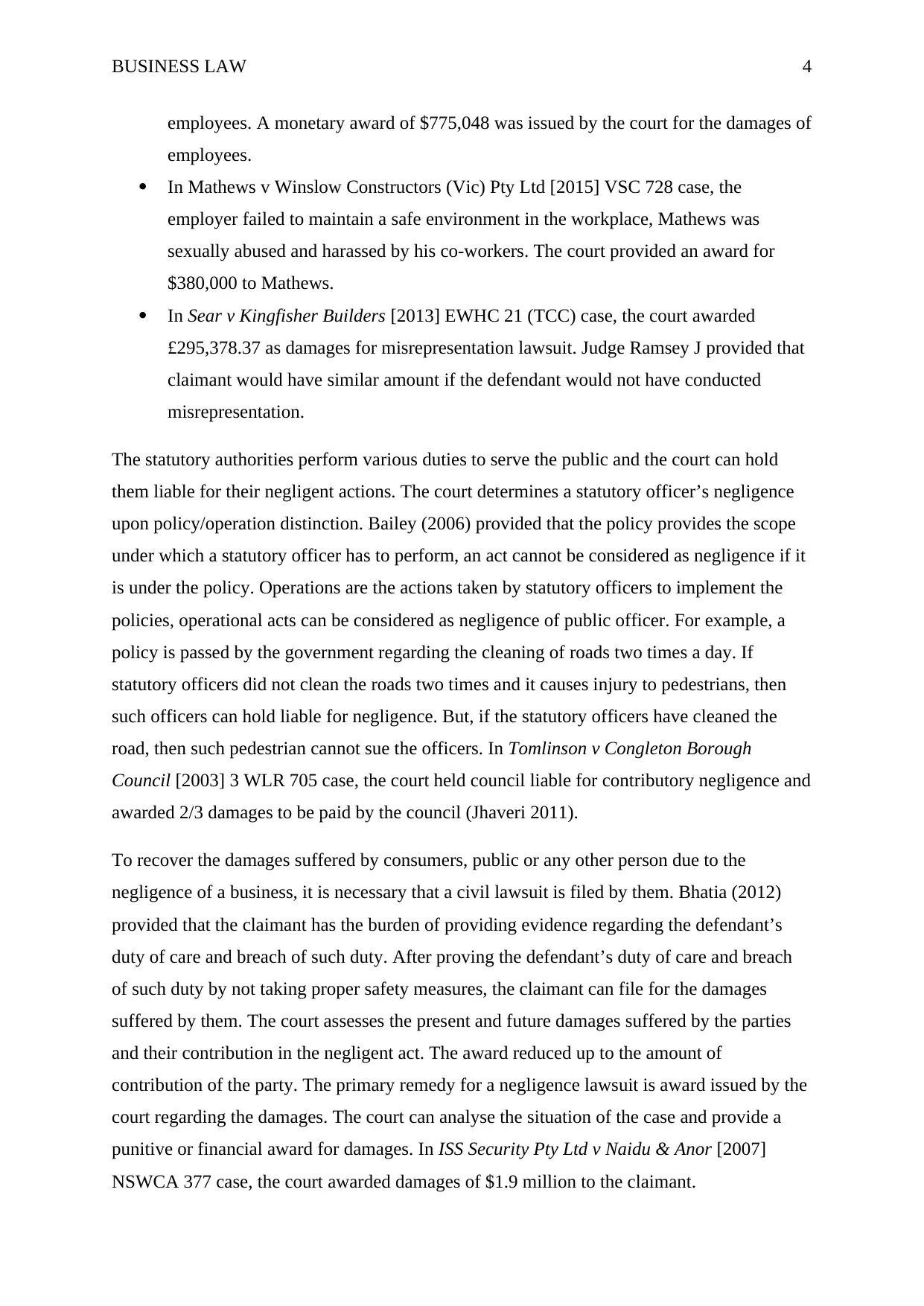
BUSINESS LAW 4
employees. A monetary award of $775,048 was issued by the court for the damages of
employees.
In Mathews v Winslow Constructors (Vic) Pty Ltd [2015] VSC 728 case, the
employer failed to maintain a safe environment in the workplace, Mathews was
sexually abused and harassed by his co-workers. The court provided an award for
$380,000 to Mathews.
In Sear v Kingfisher Builders [2013] EWHC 21 (TCC) case, the court awarded
£295,378.37 as damages for misrepresentation lawsuit. Judge Ramsey J provided that
claimant would have similar amount if the defendant would not have conducted
misrepresentation.
The statutory authorities perform various duties to serve the public and the court can hold
them liable for their negligent actions. The court determines a statutory officer’s negligence
upon policy/operation distinction. Bailey (2006) provided that the policy provides the scope
under which a statutory officer has to perform, an act cannot be considered as negligence if it
is under the policy. Operations are the actions taken by statutory officers to implement the
policies, operational acts can be considered as negligence of public officer. For example, a
policy is passed by the government regarding the cleaning of roads two times a day. If
statutory officers did not clean the roads two times and it causes injury to pedestrians, then
such officers can hold liable for negligence. But, if the statutory officers have cleaned the
road, then such pedestrian cannot sue the officers. In Tomlinson v Congleton Borough
Council [2003] 3 WLR 705 case, the court held council liable for contributory negligence and
awarded 2/3 damages to be paid by the council (Jhaveri 2011).
To recover the damages suffered by consumers, public or any other person due to the
negligence of a business, it is necessary that a civil lawsuit is filed by them. Bhatia (2012)
provided that the claimant has the burden of providing evidence regarding the defendant’s
duty of care and breach of such duty. After proving the defendant’s duty of care and breach
of such duty by not taking proper safety measures, the claimant can file for the damages
suffered by them. The court assesses the present and future damages suffered by the parties
and their contribution in the negligent act. The award reduced up to the amount of
contribution of the party. The primary remedy for a negligence lawsuit is award issued by the
court regarding the damages. The court can analyse the situation of the case and provide a
punitive or financial award for damages. In ISS Security Pty Ltd v Naidu & Anor [2007]
NSWCA 377 case, the court awarded damages of $1.9 million to the claimant.
employees. A monetary award of $775,048 was issued by the court for the damages of
employees.
In Mathews v Winslow Constructors (Vic) Pty Ltd [2015] VSC 728 case, the
employer failed to maintain a safe environment in the workplace, Mathews was
sexually abused and harassed by his co-workers. The court provided an award for
$380,000 to Mathews.
In Sear v Kingfisher Builders [2013] EWHC 21 (TCC) case, the court awarded
£295,378.37 as damages for misrepresentation lawsuit. Judge Ramsey J provided that
claimant would have similar amount if the defendant would not have conducted
misrepresentation.
The statutory authorities perform various duties to serve the public and the court can hold
them liable for their negligent actions. The court determines a statutory officer’s negligence
upon policy/operation distinction. Bailey (2006) provided that the policy provides the scope
under which a statutory officer has to perform, an act cannot be considered as negligence if it
is under the policy. Operations are the actions taken by statutory officers to implement the
policies, operational acts can be considered as negligence of public officer. For example, a
policy is passed by the government regarding the cleaning of roads two times a day. If
statutory officers did not clean the roads two times and it causes injury to pedestrians, then
such officers can hold liable for negligence. But, if the statutory officers have cleaned the
road, then such pedestrian cannot sue the officers. In Tomlinson v Congleton Borough
Council [2003] 3 WLR 705 case, the court held council liable for contributory negligence and
awarded 2/3 damages to be paid by the council (Jhaveri 2011).
To recover the damages suffered by consumers, public or any other person due to the
negligence of a business, it is necessary that a civil lawsuit is filed by them. Bhatia (2012)
provided that the claimant has the burden of providing evidence regarding the defendant’s
duty of care and breach of such duty. After proving the defendant’s duty of care and breach
of such duty by not taking proper safety measures, the claimant can file for the damages
suffered by them. The court assesses the present and future damages suffered by the parties
and their contribution in the negligent act. The award reduced up to the amount of
contribution of the party. The primary remedy for a negligence lawsuit is award issued by the
court regarding the damages. The court can analyse the situation of the case and provide a
punitive or financial award for damages. In ISS Security Pty Ltd v Naidu & Anor [2007]
NSWCA 377 case, the court awarded damages of $1.9 million to the claimant.
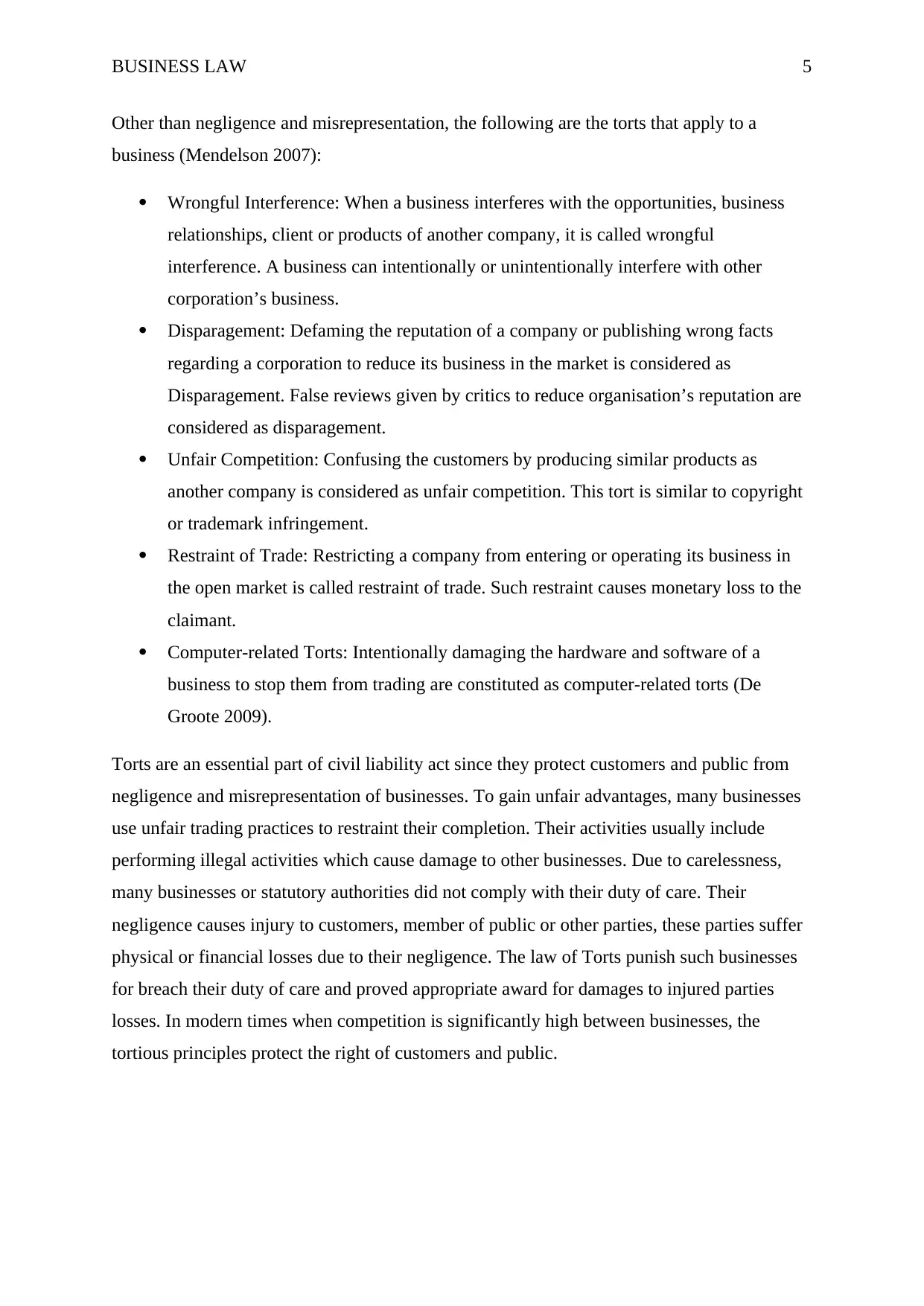
BUSINESS LAW 5
Other than negligence and misrepresentation, the following are the torts that apply to a
business (Mendelson 2007):
Wrongful Interference: When a business interferes with the opportunities, business
relationships, client or products of another company, it is called wrongful
interference. A business can intentionally or unintentionally interfere with other
corporation’s business.
Disparagement: Defaming the reputation of a company or publishing wrong facts
regarding a corporation to reduce its business in the market is considered as
Disparagement. False reviews given by critics to reduce organisation’s reputation are
considered as disparagement.
Unfair Competition: Confusing the customers by producing similar products as
another company is considered as unfair competition. This tort is similar to copyright
or trademark infringement.
Restraint of Trade: Restricting a company from entering or operating its business in
the open market is called restraint of trade. Such restraint causes monetary loss to the
claimant.
Computer-related Torts: Intentionally damaging the hardware and software of a
business to stop them from trading are constituted as computer-related torts (De
Groote 2009).
Torts are an essential part of civil liability act since they protect customers and public from
negligence and misrepresentation of businesses. To gain unfair advantages, many businesses
use unfair trading practices to restraint their completion. Their activities usually include
performing illegal activities which cause damage to other businesses. Due to carelessness,
many businesses or statutory authorities did not comply with their duty of care. Their
negligence causes injury to customers, member of public or other parties, these parties suffer
physical or financial losses due to their negligence. The law of Torts punish such businesses
for breach their duty of care and proved appropriate award for damages to injured parties
losses. In modern times when competition is significantly high between businesses, the
tortious principles protect the right of customers and public.
Other than negligence and misrepresentation, the following are the torts that apply to a
business (Mendelson 2007):
Wrongful Interference: When a business interferes with the opportunities, business
relationships, client or products of another company, it is called wrongful
interference. A business can intentionally or unintentionally interfere with other
corporation’s business.
Disparagement: Defaming the reputation of a company or publishing wrong facts
regarding a corporation to reduce its business in the market is considered as
Disparagement. False reviews given by critics to reduce organisation’s reputation are
considered as disparagement.
Unfair Competition: Confusing the customers by producing similar products as
another company is considered as unfair competition. This tort is similar to copyright
or trademark infringement.
Restraint of Trade: Restricting a company from entering or operating its business in
the open market is called restraint of trade. Such restraint causes monetary loss to the
claimant.
Computer-related Torts: Intentionally damaging the hardware and software of a
business to stop them from trading are constituted as computer-related torts (De
Groote 2009).
Torts are an essential part of civil liability act since they protect customers and public from
negligence and misrepresentation of businesses. To gain unfair advantages, many businesses
use unfair trading practices to restraint their completion. Their activities usually include
performing illegal activities which cause damage to other businesses. Due to carelessness,
many businesses or statutory authorities did not comply with their duty of care. Their
negligence causes injury to customers, member of public or other parties, these parties suffer
physical or financial losses due to their negligence. The law of Torts punish such businesses
for breach their duty of care and proved appropriate award for damages to injured parties
losses. In modern times when competition is significantly high between businesses, the
tortious principles protect the right of customers and public.
⊘ This is a preview!⊘
Do you want full access?
Subscribe today to unlock all pages.

Trusted by 1+ million students worldwide
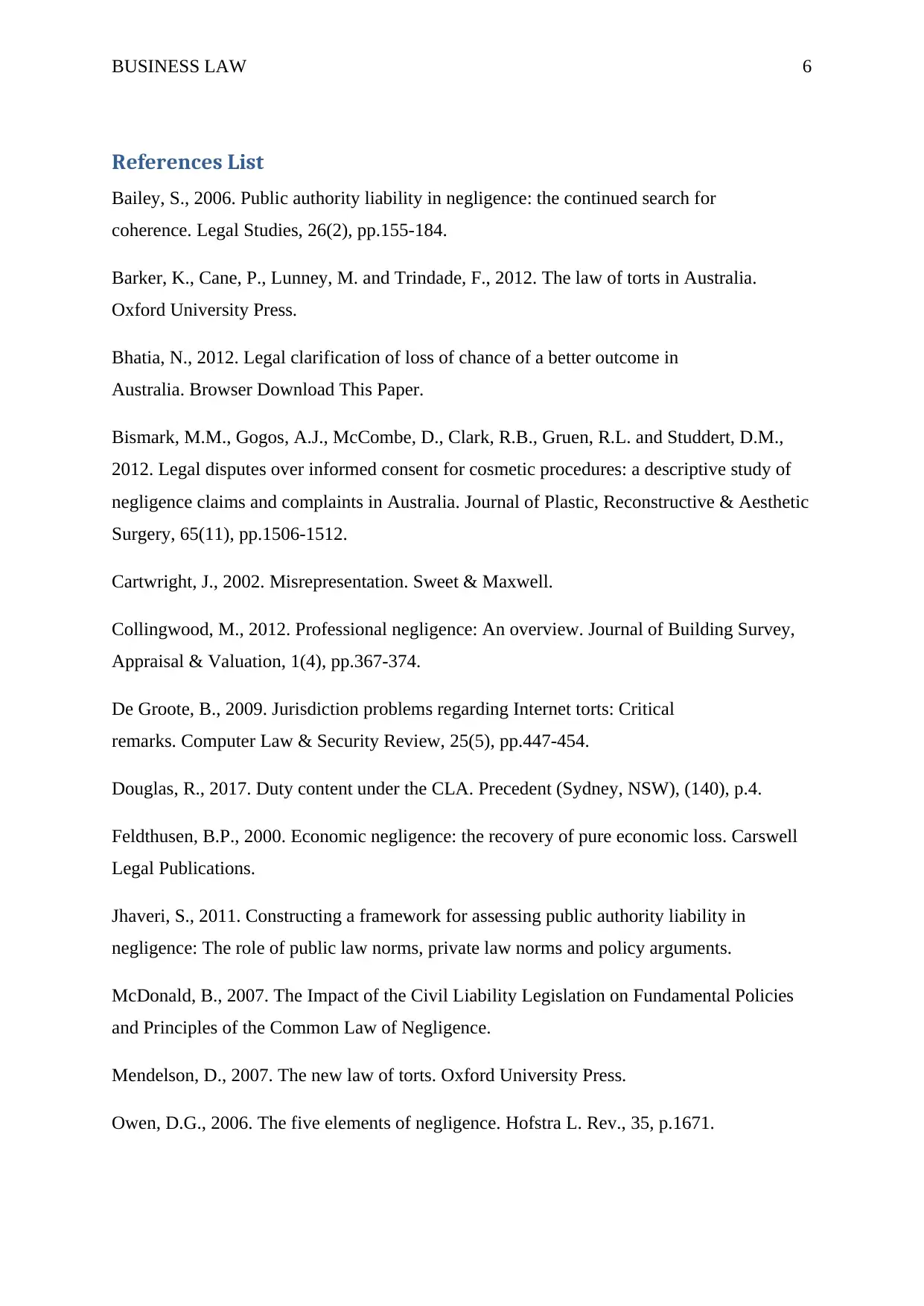
BUSINESS LAW 6
References List
Bailey, S., 2006. Public authority liability in negligence: the continued search for
coherence. Legal Studies, 26(2), pp.155-184.
Barker, K., Cane, P., Lunney, M. and Trindade, F., 2012. The law of torts in Australia.
Oxford University Press.
Bhatia, N., 2012. Legal clarification of loss of chance of a better outcome in
Australia. Browser Download This Paper.
Bismark, M.M., Gogos, A.J., McCombe, D., Clark, R.B., Gruen, R.L. and Studdert, D.M.,
2012. Legal disputes over informed consent for cosmetic procedures: a descriptive study of
negligence claims and complaints in Australia. Journal of Plastic, Reconstructive & Aesthetic
Surgery, 65(11), pp.1506-1512.
Cartwright, J., 2002. Misrepresentation. Sweet & Maxwell.
Collingwood, M., 2012. Professional negligence: An overview. Journal of Building Survey,
Appraisal & Valuation, 1(4), pp.367-374.
De Groote, B., 2009. Jurisdiction problems regarding Internet torts: Critical
remarks. Computer Law & Security Review, 25(5), pp.447-454.
Douglas, R., 2017. Duty content under the CLA. Precedent (Sydney, NSW), (140), p.4.
Feldthusen, B.P., 2000. Economic negligence: the recovery of pure economic loss. Carswell
Legal Publications.
Jhaveri, S., 2011. Constructing a framework for assessing public authority liability in
negligence: The role of public law norms, private law norms and policy arguments.
McDonald, B., 2007. The Impact of the Civil Liability Legislation on Fundamental Policies
and Principles of the Common Law of Negligence.
Mendelson, D., 2007. The new law of torts. Oxford University Press.
Owen, D.G., 2006. The five elements of negligence. Hofstra L. Rev., 35, p.1671.
References List
Bailey, S., 2006. Public authority liability in negligence: the continued search for
coherence. Legal Studies, 26(2), pp.155-184.
Barker, K., Cane, P., Lunney, M. and Trindade, F., 2012. The law of torts in Australia.
Oxford University Press.
Bhatia, N., 2012. Legal clarification of loss of chance of a better outcome in
Australia. Browser Download This Paper.
Bismark, M.M., Gogos, A.J., McCombe, D., Clark, R.B., Gruen, R.L. and Studdert, D.M.,
2012. Legal disputes over informed consent for cosmetic procedures: a descriptive study of
negligence claims and complaints in Australia. Journal of Plastic, Reconstructive & Aesthetic
Surgery, 65(11), pp.1506-1512.
Cartwright, J., 2002. Misrepresentation. Sweet & Maxwell.
Collingwood, M., 2012. Professional negligence: An overview. Journal of Building Survey,
Appraisal & Valuation, 1(4), pp.367-374.
De Groote, B., 2009. Jurisdiction problems regarding Internet torts: Critical
remarks. Computer Law & Security Review, 25(5), pp.447-454.
Douglas, R., 2017. Duty content under the CLA. Precedent (Sydney, NSW), (140), p.4.
Feldthusen, B.P., 2000. Economic negligence: the recovery of pure economic loss. Carswell
Legal Publications.
Jhaveri, S., 2011. Constructing a framework for assessing public authority liability in
negligence: The role of public law norms, private law norms and policy arguments.
McDonald, B., 2007. The Impact of the Civil Liability Legislation on Fundamental Policies
and Principles of the Common Law of Negligence.
Mendelson, D., 2007. The new law of torts. Oxford University Press.
Owen, D.G., 2006. The five elements of negligence. Hofstra L. Rev., 35, p.1671.
Paraphrase This Document
Need a fresh take? Get an instant paraphrase of this document with our AI Paraphraser
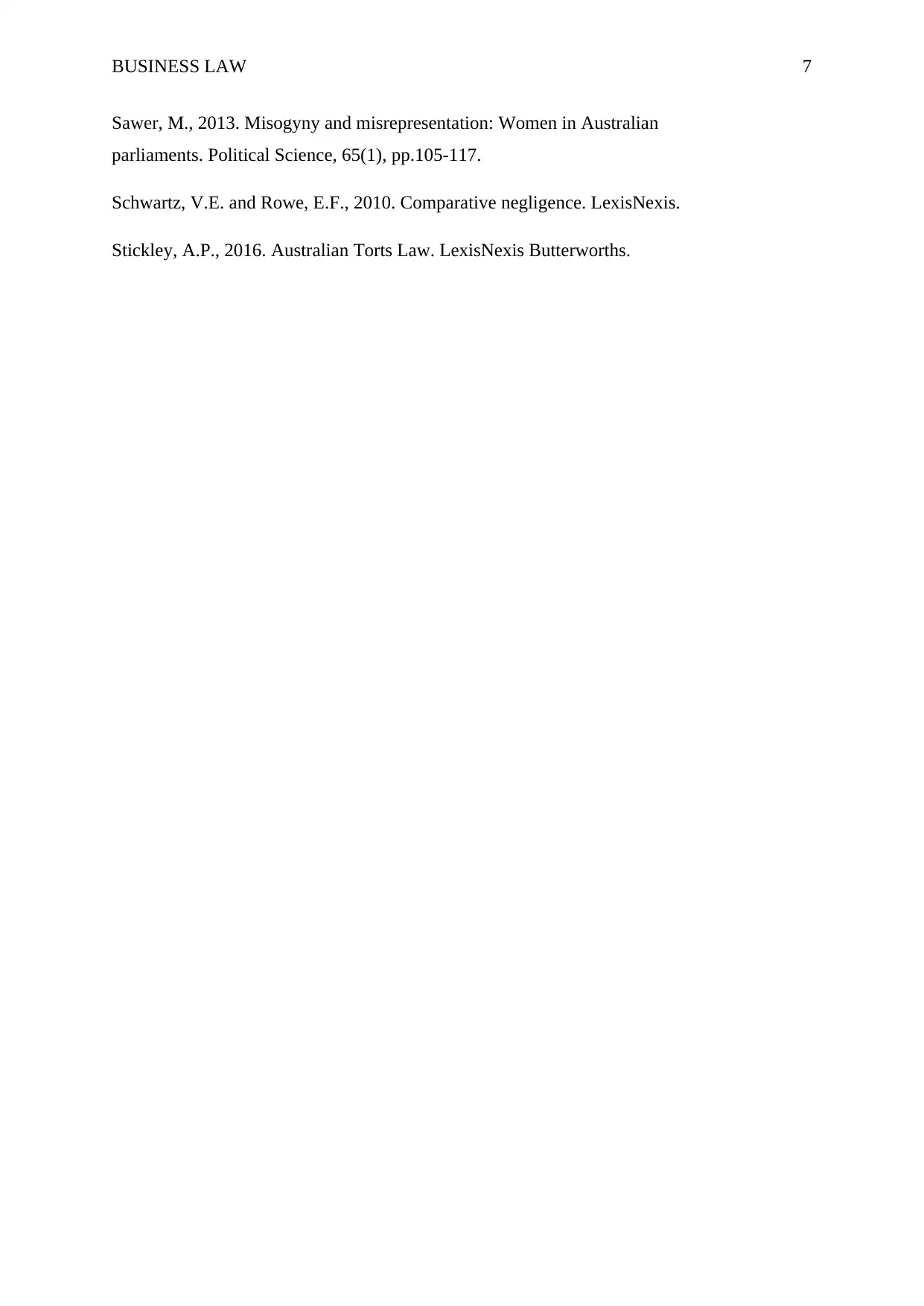
BUSINESS LAW 7
Sawer, M., 2013. Misogyny and misrepresentation: Women in Australian
parliaments. Political Science, 65(1), pp.105-117.
Schwartz, V.E. and Rowe, E.F., 2010. Comparative negligence. LexisNexis.
Stickley, A.P., 2016. Australian Torts Law. LexisNexis Butterworths.
Sawer, M., 2013. Misogyny and misrepresentation: Women in Australian
parliaments. Political Science, 65(1), pp.105-117.
Schwartz, V.E. and Rowe, E.F., 2010. Comparative negligence. LexisNexis.
Stickley, A.P., 2016. Australian Torts Law. LexisNexis Butterworths.
1 out of 8
Related Documents
Your All-in-One AI-Powered Toolkit for Academic Success.
+13062052269
info@desklib.com
Available 24*7 on WhatsApp / Email
![[object Object]](/_next/static/media/star-bottom.7253800d.svg)
Unlock your academic potential
Copyright © 2020–2025 A2Z Services. All Rights Reserved. Developed and managed by ZUCOL.





